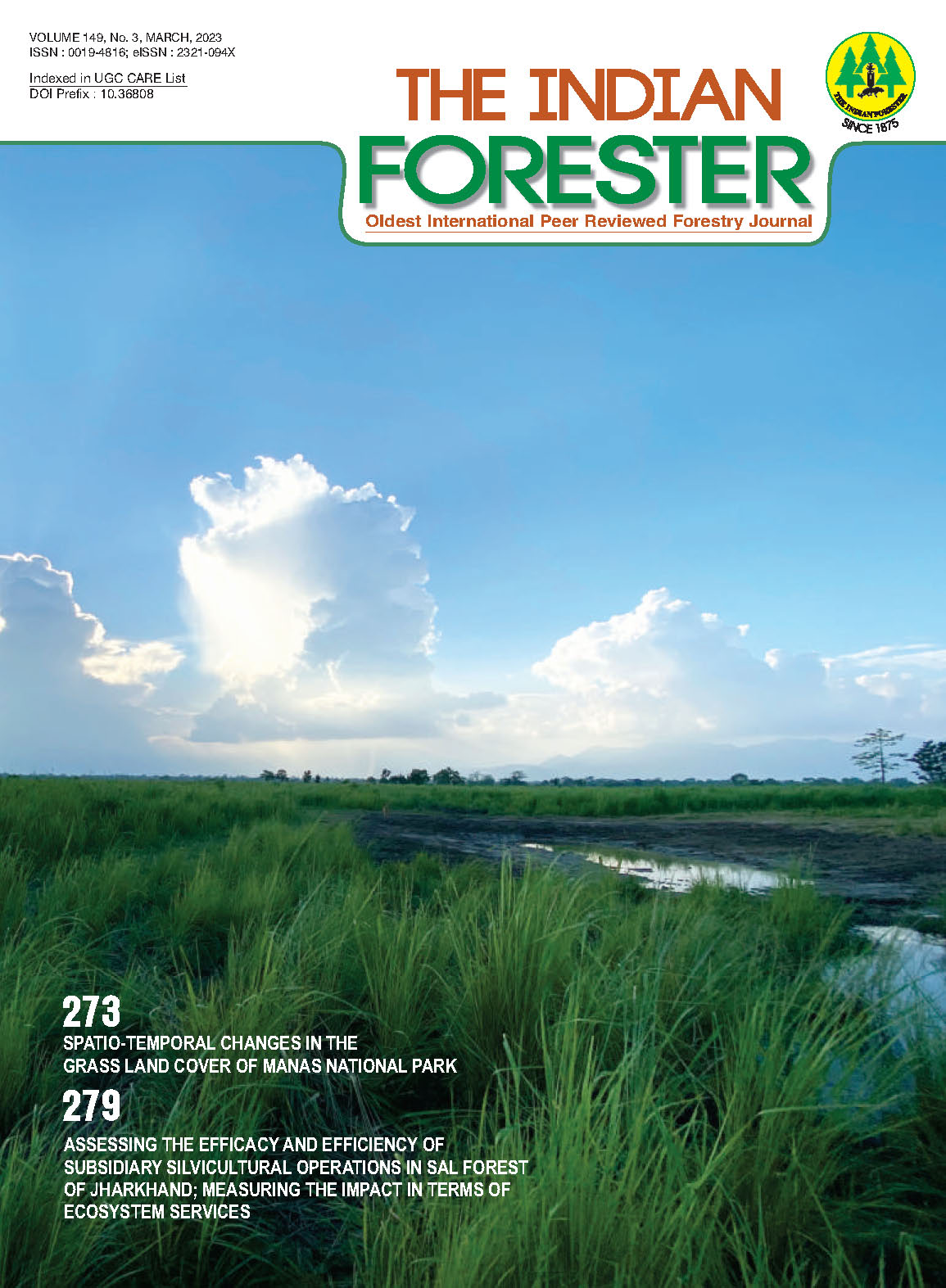Economics of Recreational Ecosystem Services : Application of Individual Travel Cost Method from Nandi Hills Forest in Karnataka
DOI:
https://doi.org/10.36808/if/2023/v149i3/156341Keywords:
Ecosystem Services, Economic Value, Travel Cost Method, Karnataka.Abstract
In the present paper the economic value of recreational services provided by Nandi Hills, Karnataka has been estimated at ₹ 2.47 billion for 2019. This study interviewed 150 tourist visitors, using a questionnaire method at the recreation site. The result of the study has found that more than 55 per cent of the respondents are willing to pay more than the existing entry fee at the recreation area. The main implications of the study are: first, development and investment opportunity for nature - based recreation areas; second, enhancing awareness of the ecosystem services; and three sustainable uses of ecosystem services at the local level.References
Balasubramanian M. (2017). Economics of Urban Ecosystem Services: A case study of Bangalore, Monograph, Institute for Social and Economic Change, Bangalore.
Chung M.G. and Kang H. (2013). Areview of ecosystem service studies: concept, approach and future work in Korea. Journal of Ecology and Environment, 36(1): 1-9.
Daniel T.C., Muhar A., Arnberger A., Aznar O., Boyd J.W., Chan K.M., Costanza R., Elmqvist T., Flint C.G., Gobster P.H. and Grêt-Regamey A. (2012). Contributions of cultural services to the ecosystem services agenda. Proceedings of the National Academy of Sciences, 109(23): 8812-8819.
Davis D. and Tisdell C.A. (1999). Tourist levies and willingness to pay for a whale shark experience. Tourism Economics, 5(2): 161-174.
De Groot R.S., Alkemade R., Braat L., Hein L. and Willemen L. (2010). Challenges in integrating the concept of ecosystem services and values in landscape planning, management and decision making. Ecological complexity, 7(3): 260-272.
Dewsbury B.M., Bhat M. and Fourqurean J.W. (2016). Areview of seagrass economic valuations: Gaps and progress in valuation approaches. Ecosystem Services, 18: 68-77.
Dixit A.M., Bandyopadhyaya S., Kumar L. and Bedamatta S. (2016). Economic Valuation of Landscape Level Wetland Ecosystem and its Services in Little Rann of Kachchh, Gujarat. The Economics of Ecosystems and Biodiversity India Initiative. GIZ India. 160.
Gera M., Yadav A.K., Bisht N.S. and Mohan G. (2008) 'Valuation of recreational benefits from Valley of Flowers National Park', Indian Forester, 134(1): 26–35
Gillespie M.A. and Wratten S.D. (2017). The role of ecosystem disservices in pest management. Environmental pest management: challenges for agronomists, ecologists, economists and policymakers: John Weily and Sons Ltd. https://scholar. google. com/scholar, pp.175-194.
Henderson K.A. and Bialeschki M.D. (2005). Leisure and active lifestyles:Researchreflections.Leisuresciences,27(5):355-365.
Limaei S.M., Ghesmati H., Rashidi R. and Yamini N. (2014). Economic evaluation of natural forest park using the travel cost method (case study; Masouleh forest park, north of Iran). Journal of Forest Science, 60(6): 254-261.
M.E.A. (2005). Ecosystems and human well-being (Vol. 5, p. 563). Washington, DC:: Island press.
Mohandas T V. and Remadevi O.K. (2011). A study on tourist visitations in protected areas of central western ghats in Karnataka, Indian Forester, 137(4): 403-410.
Mukhopadhyay P. and DaCosta V. (2015). Recreational value of coastal and marine ecosystems in India: A partial estimate : Working paper 2015-124, Madrasi School of Economics, Chennai, India.
Ninan K.N. and Inoue M. (2014). Valuing forest ecosystem services: Case study of a forest reserve in Japan. In Valuing Ecosystem Services. Edward Elgar Publishing.
Ninan K.N. and Kontoleon A. (2016). Valuing forest ecosystem services and disservices–Case study of a protected area in India. Ecosystem Services, 20:1-14.
Soe Zin W., Suzuki A., Peh K.S.H. and Gasparatos A. (2019). Economic Value of Cultural Ecosystem Services from Recreation in Popa Mountain National Park, Myanmar: A Comparison of Two Rapid Valuation Techniques. Land, 8(12): 194.
Timah P.N. (2011). Non-market valuation of beach recreation using the travel cost method (TCM) in the context of the developing world.
Vallecillo S., La Notte A., Zulian G., Ferrini S. and Maes J. (2019). Ecosystem services accounts: Valuing the actual flow of nature-based recreation from ecosystems to people. Ecological Modelling, 392: 196-211.
Verma M., Negandhi D., Khanna C., Edgaonkar A., David A., Kadekodi G., Costanza R., Gopal R., Bonal B.S., Yadav S.P. and Kumar S. (2017). Making the hidden visible: Economic valuation of tiger reserves in India. Ecosystem Services, 26: 236-244.
Downloads
Downloads
Published
How to Cite
Issue
Section
License
Unless otherwise stated, copyright or similar rights in all materials presented on the site, including graphical images, are owned by Indian Forester.





